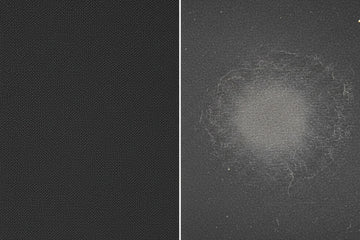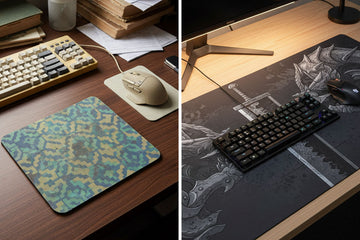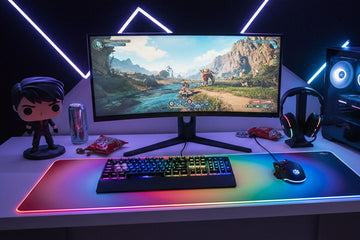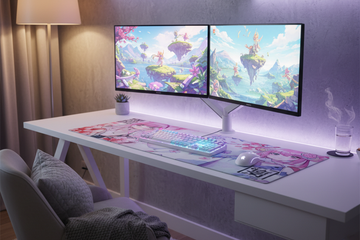If you're reading this while glancing at that trusty mouse pad that's been with you through countless gaming sessions or workdays, you're probably wondering whether it's time for an upgrade. The short answer? Yes, mouse pads absolutely wear out—and that worn surface might be sabotaging your performance more than you realize.
As someone who's tested dozens of gaming mouse pads and watched them deteriorate under heavy use, I've learned to spot the telltale signs of a pad past its prime. Whether you're rocking a premium RGB mouse pad or a basic cloth surface, understanding mouse pad wear patterns can save you from frustrating tracking issues and inconsistent performance.
How Long Do Mouse Pads Last on Average?
The typical mouse pad lifespan ranges from 6 months to 5 years, depending on multiple factors. Budget cloth pads might show significant wear within 6-12 months of daily use, while premium gaming mouse pads with reinforced surfaces can maintain their performance for 2-3 years. I've personally had high-end pads last over 4 years with proper care, though they weren't performing at their peak by that point.
Professional gamers and competitive players often replace their pads every 6-12 months, not because they're completely worn out, but because even minor surface changes can affect muscle memory and precision. Office users, on the other hand, might comfortably use the same pad for 3-5 years without noticing significant degradation.
Factors That Affect Mouse Pad Lifespan
Your mouse pad's longevity depends on several critical factors that many users overlook. Usage intensity tops the list—an 8-hour daily gaming marathon will wear down any surface faster than casual browsing. The type of mouse feet you're using matters tremendously; harder PTFE feet create more friction than softer variants, accelerating wear patterns.
Environmental conditions play a surprising role in mouse pad wear. High humidity can break down adhesives and cause fabric separation, while extreme temperatures affect rubber bases and surface coatings. I've noticed my pads deteriorate faster during humid summers, especially the edges where sweat accumulation is common. Your hand oils, dead skin cells, and occasional snack spills all contribute to the degradation process, creating a perfect storm of wear factors.
The quality of materials makes a dramatic difference. Premium pads use tighter fabric weaves, better rubber compounds, and protective coatings that resist wear. Cheaper alternatives often use looser weaves that fray quickly and thin rubber bases that crack or lose their grip within months.
Do Gaming Mouse Pads Last Longer Than Regular Ones?
Gaming mouse pads typically outlast standard office pads by a significant margin, and there's solid engineering behind this durability gap. Manufacturers design gaming surfaces to withstand the intense, repetitive movements of competitive play—think thousands of flick shots and tracking adjustments daily. These pads feature denser fabric weaves, reinforced stitching, and specialized coatings that maintain consistent glide characteristics longer.
The materials tell the story: gaming pads often use polyester blends with tighter 400-500 thread counts compared to basic pads' 200-300 counts. This density difference means gaming surfaces resist pilling and fabric separation better. Many gaming mouse pads also incorporate water-resistant coatings that protect against spills and humidity damage—features rarely found in budget office pads.
However, gaming pads face more intense usage patterns. A competitive FPS player might cover 10-20 meters of mouse movement per match, creating concentrated wear zones. Despite this punishment, quality gaming pads maintain usable performance 2-3 times longer than basic alternatives.
How Long Do RGB Mouse Pads Typically Last?
RGB mouse pads introduce an interesting durability dynamic with their electronic components adding potential failure points. The surface material typically matches standard gaming pad longevity—expect 1-3 years depending on quality. However, the LED strips and control modules present additional considerations.
Quality RGB implementations from reputable brands usually last 30,000-50,000 hours of illumination, translating to roughly 3-5 years of daily 8-hour use. I've tested several RGB models where the surface wore out long before the lighting failed. The main vulnerability lies in the cable connection point and control box, which can fail from repeated stress or accidental damage.
Budget RGB options often skimp on both surface quality and electronic components, leading to LED strip failures within 6-12 months. Uneven lighting, dead zones, or complete electrical failure become common issues. Premium RGB mouse pads from established gaming brands typically offer better longevity, though you're still adding complexity that can fail independently of surface wear.
Signs Your Mouse Pad Is Wearing Out
Recognizing when to replace your mouse pad requires understanding the subtle and not-so-subtle indicators of degradation. Many users adapt unconsciously to declining performance, not realizing how much a worn pad impacts their accuracy and comfort.

Visible Wear and Surface Damage
The most obvious wear indicators appear as physical surface changes that you can see and feel. Smooth, shiny patches develop where your mouse travels most frequently—usually in the center or along common swipe paths for gamers. These worn areas lose their original texture, creating inconsistent friction zones that throw off muscle memory.
Fraying edges signal advanced wear, especially on cloth pads without stitched borders. Once edge fraying begins, it accelerates quickly as loose threads catch on your mouse or sleeve. Fabric pilling creates tiny balls of material that interfere with sensor tracking and create an unpleasant tactile experience. I've seen pads develop visible grooves from repeated movements, particularly noticeable on softer surfaces.
Discoloration indicates accumulated oils, dead skin, and environmental contamination that cleaning can't fully remove. While some patina is normal, severe discoloration often correlates with degraded surface properties. Peeling or bubbling surfaces, especially on hybrid or coated pads, represent immediate replacement triggers as they'll only worsen with continued use.
Sensor Tracking Problems and Inconsistent Glide
Performance degradation often manifests before visible wear becomes obvious. Modern optical sensors are remarkably adaptable, but worn surfaces can still cause tracking anomalies. You might notice occasional cursor jumps, especially during slow, precise movements where sensor precision matters most.
Inconsistent glide represents the most frustrating wear symptom for gamers and precision users. Different surface zones develop varying friction levels, making it impossible to maintain consistent aim or movement speed. What felt like a smooth, predictable surface becomes a patchwork of fast and slow zones. This inconsistency forces constant micro-adjustments that fatigue your hand and destroy muscle memory.
The "muddy" feeling many users describe comes from fabric fibers matting down and losing their original texture. Initial break-in improves glide, but excessive wear creates a sluggish, high-friction surface that requires more force to move your mouse. This increased resistance leads to fatigue during extended sessions and reduces reaction speed in gaming scenarios.
When Stains and Odors Won't Go Away
Persistent stains and odors indicate deep contamination that surface cleaning can't address. Once liquids penetrate the fabric backing or rubber base, they create permanent marks and potential breeding grounds for bacteria and mold. Coffee spills, energy drinks, and food stains contain sugars and acids that break down fabric fibers and adhesives over time.
The musty smell emanating from an old mouse pad isn't just unpleasant—it signals biological activity within the material. Accumulated skin cells, oils, and moisture create an environment where microorganisms thrive. No amount of surface cleaning will eliminate organisms embedded deep in the pad's structure.
I've attempted various restoration methods on stained pads, from deep washing to alcohol treatments. While these might temporarily improve appearance, they often accelerate deterioration by breaking down adhesives or altering surface properties. Once stains and odors become permanent fixtures, replacement becomes the only practical solution.
Cloth vs Hard Mouse Pads Durability
The eternal debate between cloth and hard mouse pads extends beyond preference to practical longevity considerations. Each material type exhibits distinct wear patterns and failure modes that affect replacement frequency.
Do Cloth Mouse Pads Wear Out Faster?
Cloth mouse pads generally show wear signs earlier than hard alternatives, but "wearing out" means different things for each surface type. Cloth pads gradually degrade through fabric wear, developing the smooth patches and inconsistent zones discussed earlier. This degradation happens progressively over months or years, allowing you to adapt somewhat to changing surface properties.
The fabric surface acts like fine sandpaper on mouse feet, creating a symbiotic wear relationship. As the cloth smooths down, mouse feet wear slower, though this comes at the cost of reduced control. Heavy users might notice significant cloth degradation within 6-12 months, while moderate users could enjoy 2-3 years of acceptable performance.
Cloth's vulnerability to liquids, oils, and environmental factors accelerates wear compared to non-porous hard surfaces. However, cloth pads often remain "usable" longer even when worn, whereas hard pads tend to fail more catastrophically when their coating deteriorates.
Are Hard Pads Truly Long-Lasting?
Hard mouse pads promise superior durability, and they generally deliver on raw longevity—with important caveats. Quality hard pads from aluminum, glass, or high-grade plastic can last 5-10 years without significant surface changes. The non-porous surface resists stains, liquids, and environmental factors that plague cloth alternatives.
However, hard pad "failure" tends to be sudden and complete rather than gradual. Once the surface coating wears through—typically in high-traffic areas—the pad becomes essentially unusable. The exposed substrate might cause sensor tracking issues or excessive mouse feet wear. Unlike cloth pads that degrade gradually, hard pads often go from perfect to problematic quickly.
The durability trade-off comes in mouse feet wear. Hard surfaces absolutely demolish PTFE feet, requiring replacement every 2-4 months versus 6-12 months on cloth. When calculating total cost of ownership, factor in 3-4 times more frequent feet replacements with hard pads.
Which Is Better for Longevity?
For pure longevity, hard pads win—but the complete picture is more nuanced. A quality hard pad might last 5+ years, but you'll spend considerably more on replacement mouse feet during that period. The surface either works perfectly or fails completely, with little middle ground.
Cloth pads offer predictable, gradual degradation that many users find manageable. You can extend usability through cleaning and maintenance, and even worn cloth pads remain functional for non-critical tasks. The lower initial investment makes periodic replacement less painful financially.
For most users, I recommend quality cloth gaming mouse pads with reinforced edges and protective coatings. They offer the best balance of longevity, performance consistency, and value. Serious competitive players who prioritize absolute consistency might prefer hard pads despite the mouse feet expense, while office users can succeed with either option based on preference.

Can You Extend the Life of a Mouse Pad?
Proper maintenance can double or even triple your mouse pad lifespan, yet most users never clean their pads properly—if at all. Understanding preservation techniques helps maximize your investment and maintain consistent performance longer.
Best Cleaning and Maintenance Practices
Regular cleaning prevents the accumulation of contaminants that accelerate wear. For cloth pads, I recommend weekly surface cleaning with a lint roller or soft brush to remove debris and skin cells. Monthly deep cleaning involves gentle hand washing with mild detergent and lukewarm water. Avoid harsh chemicals or machine washing, which can damage adhesives and alter surface properties.
The cleaning process matters as much as frequency. Submerge the pad in lukewarm water with a few drops of dish soap, gently agitating with your hands. Focus on visible stains without aggressive scrubbing that damages fibers. Rinse thoroughly—soap residue attracts dirt and affects glide. Air dry flat, avoiding direct sunlight or heat that can warp the rubber base.
Hard pads require less intensive maintenance but aren't maintenance-free. Weekly wiping with isopropyl alcohol removes oils and maintains surface consistency. Pay attention to texture patterns where debris accumulates. Glass and metal pads can handle more aggressive cleaning when needed, but avoid abrasives that might scratch protective coatings.
Does Storage Method Affect Durability?
Storage significantly impacts mouse pad longevity, particularly for users who transport their gear regularly. Rolling cloth pads creates permanent creases and separates layers, while folding causes catastrophic damage. Always roll with the surface facing outward to minimize stress on the fabric-rubber bond.
Extended desk mats face unique storage challenges due to their size. If you must store them rolled, use a tube diameter of at least 3 inches to prevent tight curves that create permanent warping. Store flat when possible, avoiding stacking heavy items that compress the surface.
Environmental storage conditions matter more than most users realize. Extreme temperatures weaken adhesives, while humidity promotes mold growth and material degradation. Store pads in climate-controlled environments away from direct sunlight. Avoid attics, garages, or vehicles where temperature fluctuations accelerate aging.
Can Stitched Edges and Coatings Add Years?
Stitched edges represent one of the best durability investments for cloth mouse pads. The stitching prevents edge fraying—often the first failure point for basic pads. Quality stitching adds 1-2 years of usable life by maintaining structural integrity even as the surface wears. Look for flat, tight stitching that won't irritate your wrist during extended sessions.
Surface coatings provide another longevity boost, though results vary significantly. Water-resistant treatments prevent liquid penetration and make cleaning easier, reducing contamination-related wear. Some coatings also resist oil absorption, keeping the surface cleaner longer. However, these coatings can alter glide characteristics and may wear off unevenly, creating inconsistent surface properties.
The latest micro-texture coatings promise extended durability while maintaining performance. These treatments reinforce individual fibers rather than creating a surface layer, providing protection without significantly altering feel. While more expensive initially, pads with quality coatings and stitched edges often prove more economical long-term.
When Should You Replace a Mouse Pad?
Knowing precisely when to replace your mouse pad requires balancing performance needs, budget considerations, and usage requirements. The decision point varies dramatically between users, but certain triggers should prompt immediate replacement consideration.
Is Performance Decline a Clear Signal?
Performance degradation should trigger replacement consideration before complete failure occurs. If you're constantly fighting your equipment rather than focusing on your task, the pad has outlived its usefulness. This threshold varies by user—competitive gamers might replace at the first sign of inconsistency, while casual users tolerate more degradation.
Watch for performance patterns that indicate replacement time: increasing hand fatigue from fighting high friction, inconsistent cursor movement requiring constant readjustment, or difficulty maintaining precision during important tasks. When you notice yourself overcompensating for equipment deficiencies, replacement time has arrived.
The "adaptation trap" catches many users who gradually adjust to declining performance without realizing how much capability they've lost. If you're curious, borrow a friend's newer pad or visit a store to test fresh surfaces. The difference often shocks long-term users who've unconsciously adapted to degraded equipment.
Can an Old Mouse Pad Hurt Gaming Accuracy?
Absolutely—worn mouse pads devastate gaming accuracy through multiple mechanisms. Inconsistent surface zones force constant aim adjustment, disrupting muscle memory development. You might nail headshots in one screen area but consistently miss in another due to surface variation.
The psychological impact compounds physical limitations. Uncertainty about equipment reliability creates hesitation and reduces confidence. Split-second decisions suffer when you're subconsciously calculating surface compensation. I've watched players improve dramatically after replacing worn pads, not through skill development but by removing equipment-imposed handicaps.
Competitive integrity demands consistent equipment performance. Professional players replace pads at the slightest indication of wear because minor inconsistencies compound into major disadvantages. While casual players can tolerate more degradation, anyone seeking improvement should prioritize equipment consistency.
Are Cheap Mouse Pads Worth Replacing More Often?
The economics of frequent cheap pad replacement versus investing in quality deserves careful consideration. Budget pads costing $10-15 might need replacement every 6 months, totaling $20-30 annually. A premium $40-60 gaming mouse pad lasting 2-3 years provides better long-term value while maintaining superior performance throughout its lifespan.
However, strategic cheap pad usage makes sense in certain scenarios. If you're experimenting with different surface types or sizes, budget options let you explore preferences without major investment. Temporary setups or secondary locations might not justify premium pads. Some users prefer the consistency of frequent replacement with identical cheap pads over adapting to gradual premium pad degradation.
Consider total ownership cost including mouse feet replacement, cleaning supplies, and time investment. Premium pads often prove economical when factoring these elements, particularly for users valuing consistent performance. Budget options work for casual users who prioritize low initial cost over long-term value.
FAQs About Mouse Pad Wear and Replacement
How Often Should You Replace a Gaming Mouse Pad?
Competitive gamers should consider replacement every 6-12 months to maintain peak performance, while enthusiast gamers can extend to 12-24 months depending on usage intensity. The replacement frequency depends on your performance standards—professionals can't afford any equipment-induced inconsistency, while casual players might tolerate minor degradation.
Signs indicating replacement time include visible wear patterns, inconsistent glide, or difficulty maintaining your usual performance level. Don't wait for complete failure; proactive replacement maintains consistency and prevents adaptation to degraded equipment. Consider keeping a backup pad to A/B test against your current surface periodically.
Can You Repair a Mouse Pad Instead of Replacing It?
While some restoration attempts might temporarily improve appearance, true repair isn't practically feasible for most mouse pad damage. Surface-level fixes like trimming frayed edges or cleaning stains address symptoms without fixing underlying degradation. Attempting to resurface or recoat worn areas typically creates more problems than solutions.
Edge fraying can be minimized by carefully applying fabric glue or clear nail polish to prevent further unraveling, but this doesn't restore original performance. Some users report success using fabric shavers to remove pilling, though this risks damaging the surface further. Generally, when considering repair time and materials, replacement proves more practical.
Do Extended Desk Mats Wear Out Faster?
Extended desk mats and large mouse pads don't necessarily wear faster overall, but they develop uneven wear patterns more noticeably. The mouse zone experiences intense use while keyboard and peripheral areas remain pristine, creating stark contrast between worn and unworn sections. This localized wear can feel more frustrating than uniform degradation across smaller pads.
The benefits often outweigh wear concerns—extended mats protect desk surfaces, reduce noise, and provide consistent surface across your entire workspace. Many users rotate their desk mats periodically, moving worn areas outside the primary mouse zone to extend usability. The larger surface area also allows repositioning your mouse zone when wear becomes noticeable.
Final Thoughts: Choosing a Durable Mouse Pad
Features That Improve Longevity
When shopping for maximum durability, prioritize these key features: stitched or reinforced edges that prevent fraying, water-resistant coatings that facilitate cleaning and prevent deep contamination, and premium base materials that resist warping and maintain grip over time. Thread density above 400 count for cloth pads indicates superior wear resistance.
Consider pad thickness carefully—3-4mm provides an optimal balance of comfort and durability without excessive material that might separate. Natural rubber bases outlast synthetic alternatives, maintaining flexibility and grip longer. Anti-slip textures molded into the base prove more durable than applied coatings that wear off.
Look for brands offering warranties or satisfaction guarantees, indicating confidence in longevity. Research user reviews focusing on long-term durability rather than initial impressions. Premium pads from established gaming peripheral manufacturers typically offer superior longevity through better materials and construction techniques.

Upgrade Options: Gaming Mouse Pads, Extended Desk Mats, and Large Mouse Pads
If your pad is showing its age, explore high-quality gaming mouse pads, extended desk mats, and large mouse pads designed for durability and performance. Modern gaming mouse pads incorporate advanced materials and construction techniques that significantly extend lifespan while maintaining consistent performance. Whether you need an RGB mouse pad for aesthetic appeal, an ergonomic mouse pad for comfort, or a competition-grade surface for peak performance, investing in quality equipment pays dividends through extended lifespan and sustained performance. Don't let a worn mouse pad hold back your potential—upgrade to a surface that matches your ambitions and maintains its properties through years of intensive use.




